
[ad_1]
The mattress business is targeted on placing collectively the mattresses that give customers a very good night time’s sleep. However in a round financial system, how these mattresses get taken aside on the finish of their helpful lives issues, too. We discuss to recyclers about their course of, challenges and ideas on the long run.
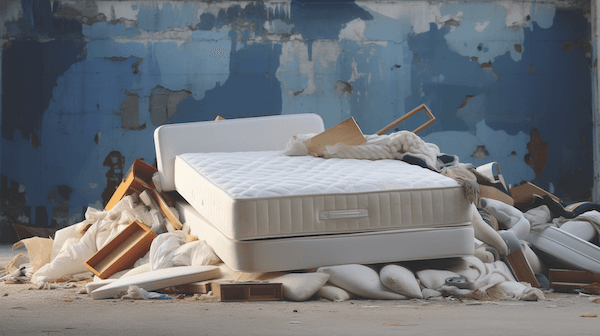
Whereas the manufacturing vegetation that give start to new mattresses are more and more automated, the amenities that dismantle these mattresses for recycling on the finish of their helpful lives are nonetheless largely guide operations. Suppose workers with utility knives, chopping, ripping and separating bedding parts into piles.
Mike Crowell, market space supervisor for Rutland, Vermont-based Casella Waste Programs Inc., which operates a mattress recycling facility in Willimantic, Connecticut, estimates that 90% of the disassembly course of is guide.
However U.S. recyclers say they’ll be capable to spend money on automation if demand for recycling providers grows in response to customers changing into extra involved about problems with sustainability, landfills cease taking cumbersome objects like mattresses, and extra states be part of California, Connecticut, Oregon and Rhode Island in creating statewide mattress recycling packages.
For instance, as mattress recycling expands, investing in new automated programs for dismantling pocketed coil models can turn out to be less expensive, recyclers say.
Most mattress producers — and their suppliers — spend much more time listening to what occurs on their very own manufacturing unit flooring than serious about what occurs at a recycling facility down the highway.
That’s comprehensible, however that’s altering, too, because the sleep merchandise business embraces the idea of sustainability and strives to cut back waste, vitality use and emissions throughout the provision chain whereas discovering new makes use of for mattress parts at their finish of life.
So, BedTimes talked with U.S. mattress recyclers about what occurs, step-by-step, at their amenities, the challenges they face, the alternatives they see forward — and why they suppose it’s necessary that the remainder of the mattress business know what they do.
The primary steps
Mattresses are large and hulking, so a facility that dismantles them for recycling must be “a big, open area with excessive ceilings, which helps with hearth security and prevention,” says Michelle Williams, president of Mat Recyclers, which has an roughly 60,000-square-foot facility in Rancho Cucamonga, California. The one different important requirement: loading docks for the vans bringing models into the ability and the commodities consumers’ vans taking the disassembled parts again out to be recycled into new merchandise.
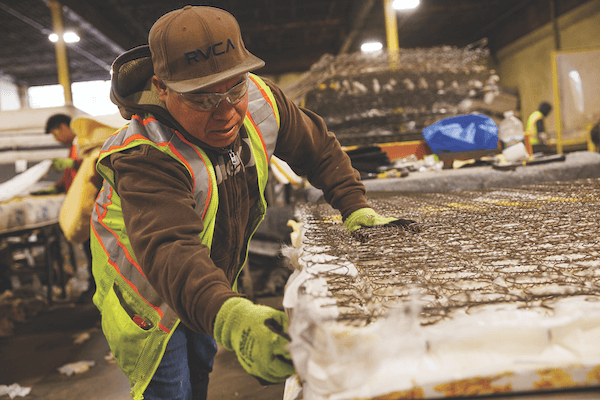
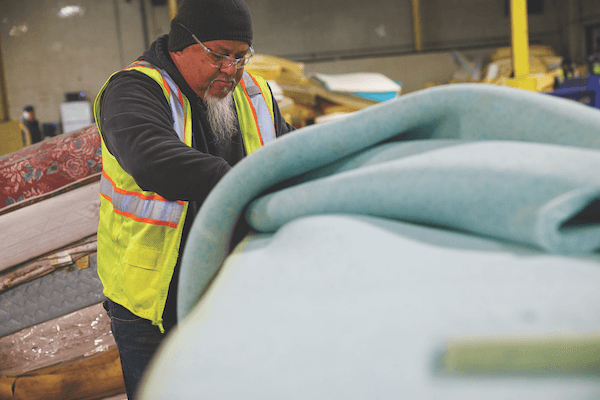
Within the case of recyclers in California, Connecticut, Rhode Island and shortly to be Oregon, most mattresses arrive by way of the Mattress Recycling Council, which administers these statewide recycling packages and contracts. Mattresses are collected from a wide range of sources together with waste switch stations, public assortment occasions and huge quantity sources like mattress retailers, hospitals, motels and universities. MRC additionally contracts with transporters in every state to maneuver discarded mattresses to the closest recycling facility.
As soon as the used mattresses are counted and unloaded, they’re stacked close to the workstations of workers, the place staff then use utility knives to chop and rip them aside into parts.
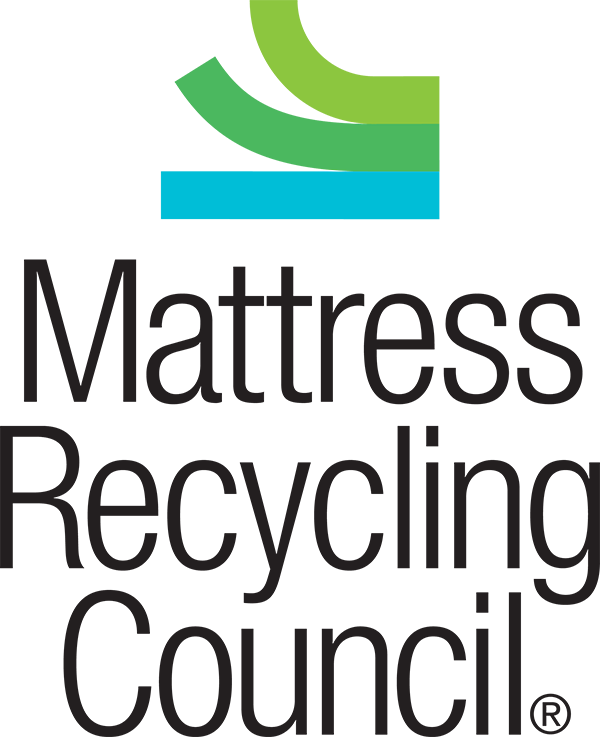
Extra Than a Supervisor: The Mattress Recycling Council, a nonprofit created in 2013 by the Worldwide Sleep Merchandise Affiliation to implement statewide recycling packages, does greater than handle the ins and outs of these efforts. MRC invests almost $1 million a 12 months to develop efficiencies in mattress assortment, transportation, and deconstruction and analysis new and higher makes use of for recycled supplies. For instance, an MRC grant helped develop a prototype machine to dismantle pocketed coil models. Be taught extra at MattressRecyclingCouncil.org.
Matt Baltz, operations supervisor on the Casella-owned mattress recycling facility in Willimantic, says the method can look “barbaric” however that it’s efficient. Casella is among the largest strong waste administration firms in the USA, serving residential, industrial, municipal, institutional and industrial prospects in additional than 40 states. It additionally operates a smaller mattress recycling facility in Buffalo, New York.
As they disassemble the beds — Baltz and the Casella crew name the method “decasing” — staff stack related supplies (quilt, foam, innerspring models, pocketed coils, cotton, shoddy, and many others.) in piles round their workstations.
Casella operates two dismantling strains at its 18,000- square-foot facility in Willimantic. The power recycles about 65% of the mattresses in Connecticut, Crowell says, but in addition takes in mattresses from different Casella amenities in Maine, New Hampshire, New York, Vermont and shortly Pennsylvania. By means of these streams, the ability processed about 150,000 mattresses in 2022 and 184,000 final 12 months.
Williams compares the method of dismantling a mattress to “disassembling a sandwich — taking the bread and meat and cheese layers aside — as a result of every layer of the mattress is disposed of in another way.”
“Or consider it like opening an Amazon bundle,” she continues. “You open the cardboard field, separate the plastic insulating supplies out, take the product out of the packaging after which dispose of every of these supplies in another way. It doesn’t matter if it’s a king dimension, queen dimension or a mattress from a cruise ship or a hospital. All of them get dismantled the identical manner.”
Skilled workers work rapidly. Williams says essentially the most environment friendly members of her 24-person crew can dismantle 100 mattresses in a shift.
“They’re extremely environment friendly since you’re not attempting to take care of the integrity of the items, proper? You need the parts as complete as doable if you’re going to be baling them, nevertheless it isn’t a finesse exercise the place you must fear about clear sew breaks or issues like that,” she says.
At this early dismantling stage of the mattress recycling course of, security is as necessary as pace. “We’re most involved about getting the mattress dismantled as rapidly as doable however doing it safely, so no person will get harm within the course of,” Williams says. Along with utilizing utility knives, workers put on gloves and eye safety. Casella’s staff additionally put on Kevlar sleeves, Baltz notes.
Automation aids
As staff accumulate piles of parts round their workstations, forklift operators decide up these stacks, shifting the supplies to the following stage of the method. And that’s the place some automation can are available.
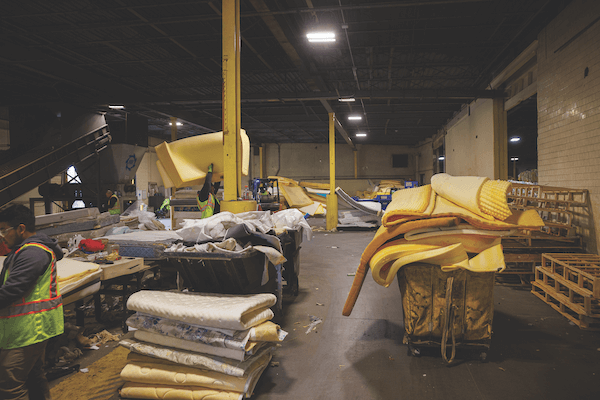
U.S. recyclers use machines to separate the metal springs from the wooden in conventional field spring models. Bigger recyclers at the moment are utilizing industrial shredders to prepared the metal and another parts on the market to finish markets.
Pocketed coil models have been an issue for mattress recyclers, as it’s tough to separate the polypropylene material from the metal and much too many have ended up in landfills. However that is an space the place developments in shredding automation are proving helpful — and worthwhile.
In late 2023, Casella put in an automatic system from Florence, Kentucky-based Pocket Coil Recycling in its Willimantic mattress recycling facility to dismantle and separate pocketed coil models into metal and polypropylene material, that are among the many most profitable mattress parts. Crowell says the system can course of 32 pocketed coil models an hour: “We top off about 500 models after which run it in a two-shift interval.”
“I couldn’t imagine the effectiveness of the system,” Crowell says. “We estimated (that earlier than putting in the equipment) we had been disposing of 40 tons of pocketed coils a month as a result of we couldn’t deal with them. And now we’re capturing that metallic and polypropylene (for resale to commodities brokers). We’re very excited with the outcomes that we’re attaining.”
At the moment, Mat Recyclers outsources pocketed coil recycling to a different California recycler however hopes quickly to buy a pocketed coil machine to dismantle these models in-house — and revenue from the metal and polypropylene material.
As for that preliminary stage of dismantling, now dealt with manually in the USA, Crowell notes that there are “automated programs in use in Europe that can absolutely decase a mattress, separating all the combination of merchandise popping out of it — the froth, the topper material, the shoddy, the jute.” However, for now, these programs are too expensive to be price efficient for many U.S. recyclers.
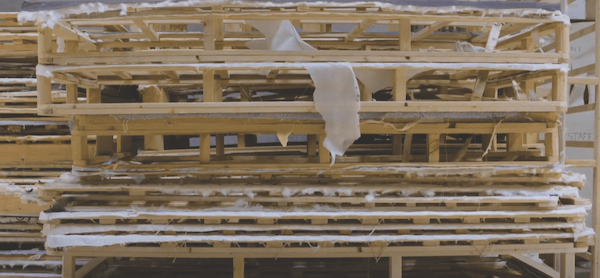

together with investigations into new and higher makes use of for used mattress parts.
And Williams isn’t certain that an automatic system could be a lot better than the present methodology, which she calls “extremely environment friendly.” “Actually, I don’t know if a machine might do the identical quantity,” she says. “And the opposite drawback is that there’s a actual lack of uniformity inside a (home) mattress. It’s not simply the varied sizes — every part from a hospital mattress to a California king — however virtually each mattress is completely different by way of the way it’s assembled. The quilts are completely different, the adhesives are completely different, the layers of foams, the kinds of foams, the kinds of coils. There are simply so many alternative parts, assembled in another way — extra selection than within the European bedding market (the place foam models are extra prevalent), I feel.”
However Crowell expects U.S. recyclers to proceed so as to add know-how and automation as recycling quantity grows. Casella, he says, is dedicated to investing in mattress recycling, and in making the method extra environment friendly and cost-effective.
Variable markets
As soon as parts are stacked, shredded, baled or in any other case prepped, they’re picked up by commodities consumers. The frequency of pickups depends upon the quantity and sort of fabric collected, recyclers say. Some commodities consumers decide up hundreds a number of instances per week; different parts get picked up weekly, biweekly, month-to-month and even much less incessantly. As an example, till Mat Recyclers buys its personal machine to dismantle pocketed coil models, it has these cumbersome objects picked up a number of instances per week to save lots of area and maintain its facility working effectively.

Adrienne Farrar Houël is president and CEO of Larger Bridgeport Group Enterprises Inc., a nonprofit neighborhood growth company centered on vitality conservation that operates the Park Metropolis Inexperienced mattress recycling division in Bridgeport, Connecticut, operates equally.
“Pickup instances differ extensively,” Houël says. “… However nothing is stored right here for very lengthy. We don’t need stuff sitting round.”
Commodities markets fluctuate, however recyclers say metal is usually essentially the most worthwhile part.
“It’s persistently on the excessive finish,” Houël says. “Proper now, it’s $210 a ton, so it’s fairly profitable.”
Shoddy and coir (a coconut fiber) are all the time tough to discover a purchaser for, Crowell says, and these days, the marketplace for polyurethane foam has been weak. That foam is used to make carpet pad, and when residential housing and industrial constructing markets cool, so does demand for carpet and carpet pad. (See story on web page 32 in regards to the Mattress Recycling Council’s efforts to seek out markets for mattress supplies.)
Cotton could be bothersome for recyclers as a result of it’s not captured in excessive volumes in previous mattresses and there isn’t a giant post-consumer marketplace for it.
“You run throughout it, however there isn’t sufficient cotton to barter for pickup a couple of times a month, so you’ve gotten it sitting round for six months earlier than getting sufficient to fill a truck,” Houël says. “And it’s very low cost by way of the commodities market: It runs between 4 cents and 6 cents a pound.”
Crowell says Casella’s Willimantic facility advantages from its proximity to each a Casella-owned metals yard and a development recycling facility. All its shredded and baled metallic goes to the metals yard, from which it makes its strategy to metal mills and foundries. Wooden from mattress foundations is both shredded and used for biomass gas or used for mulch functions.
Working collectively
Mattress recyclers acknowledge that mattress producers’ precedence ought to be creating the standard, supportive mattresses that give customers a very good night time’s sleep. However they’re happy to see each producers and their suppliers taking an curiosity in mattress end-of-life points.

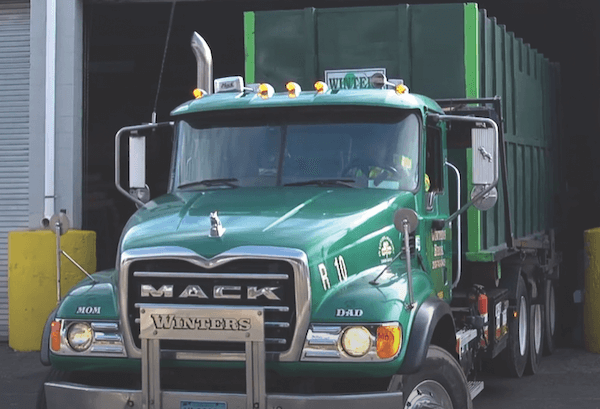
mattress recyclers settle for models from each personal waste haulers and people who contract with MRC.
By higher understanding the challenges recyclers face, together with discovering markets for some parts, producers might be able to alter each the supplies they use and their development strategies. As an example, realizing the problem of dismantling pocketed coil models, springs makers are arising with new supplies and constructions that make the separation course of simpler.
To assist elevate consciousness about recycling challenges amongst mattress producers, MRC and ISPA facilitate discussions amongst recyclers and producers on the ISPA Sustainability Convention and host excursions for ISPA members at recycling amenities.
Moreover, MRC has assembled two workgroups to spur discussions on the deconstruction and recycling of mattresses and encourage producers and suppliers to deal with end-of-life points.
The business workgroup on round design helps members of the worth chain contemplate end-of-life recycling challenges when designing new parts and mattresses. MRC shares classes realized from mattress deconstruction and recycling to assist discover methods to cut back waste and allow extra and higher-value recycling of mattress parts.

The business workgroup on new supplies identifies new parts or applied sciences not too long ago launched to the market which will pose recycling challenges. It additionally advises MRC on anticipated long-term modifications in product combine and raises business consciousness about how design and advertising and marketing selections can have an effect on recycling. Finally, the sort of data helps MRC’s researcher crew and recyclers put together for the long run.
If recyclers know what parts are in style in at the moment’s mattresses, they’ve time to reply to any potential challenges forward, given the comparatively lengthy lag between when most customers buy a mattress and after they get rid of it. (The typical age of a discarded mattress obtained by MRC recyclers at the moment is 13.9 years.)
“We are able to have 10 years between while you manufacture a brand new mattress and once I obtain it at my recycling facility — that’s 10 years to develop an answer,” Williams says. “… There must be understanding on either side — the meeting and the disassembly course of — to make the fitting trade-offs.”
For extra in-depth protection, see “Taking It All Aside” within the digital version of BedTimes journal.
[ad_2]